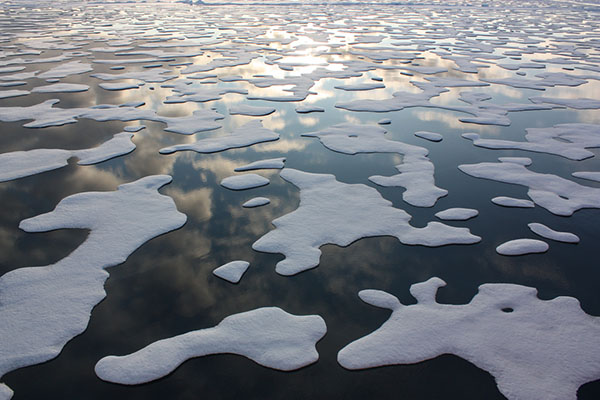
by Andrew Urevig Thursday, August 27, 2015

New satellite data show that the skies over the Arctic Ocean are warming, which is increasing humidity and cloud cover over the region. Credit: NASA/Kathryn Hansen
At least since satellite observations began four decades ago, climbing temperatures have chipped away at Arctic sea ice, causing earlier spring melting and later autumn freezing. Because ice reflects more sunlight than water does, shrinking sea-ice cover means that Arctic waters soak up more solar energy, which affects climate both regionally and globally. Now, a new study has documented how Arctic warming leads to wetter air and increased cloud cover, particularly during autumn and winter, which spurs even more warming in a self-reinforcing cycle.
Researchers analyzed the first decade’s worth of data collected over the Arctic by the Atmospheric Infrared Sounder (AIRS) aboard NASA’s Aqua satellite between 2003 and 2013. During that period, average air temperatures above the Arctic Ocean rose by 1.5 degrees Celsius while the temperature at the sea and ice surface rose by 2.5 degrees. Evaporation from the ocean surface increased as well, adding an average of 0.81 kilograms of water vapor per square meter to the lower atmosphere, which increased the humidity in the region.
Warmer air and ice-surface temperatures mean that sea ice typically begins melting earlier in the spring than it once did, which lengthens the portion of the year in which much of the Arctic Ocean is ice-free. This causes the Arctic to absorb more sunlight, adding heat to the ocean and causing the increased evaporation, reported Linette Boisvert, a research scientist at NASA’s Goddard Space Flight Center in Greenbelt, Md., and Julienne Stroeve, a senior research scientist at the National Snow and Ice Data Center in Boulder, Colo., in Geophysical Research Letters.
This evaporation continues into autumn, the researchers found, contributing to increasing cloudiness as air temperatures cool and much of the excess water vapor condenses. All of these processes combine to “create a positive feedback loop in which there’s more warming and more melting of the sea ice,” Boisvert says.
The extra clouds act “like a blanket to help trap the heat from the ocean in the autumn and early winter [and stop it from] from escaping to space,” says Stephen Vavrus, a climatologist at the University of Wisconsin at Madison, who was not involved in the study. The extra heat then delays ice formation.
Thus, earlier melting of ice in the spring contributes to the later freezing of ice in the winter, fueling a pattern in which the Arctic continually becomes warmer and wetter.
“One of the harder variables to measure in the Arctic is the humidity,” Boisvert says, “because we don’t have a lot of … in situ observations to compare” to the satellite data]. The dearth of field observations of Arctic humidity leads to uncertainty in data analysis, which she says “makes it difficult to get the magnitude of the evaporation correct.”
The AIRS data aren’t perfect, but Boisvert notes that the upward annual trend for specific humidity is bigger than the range of error, suggesting it’s statistically significant. And if these humidity and temperature trends continue, Boisvert and Stroeve wrote that they anticipate an eventual “new Arctic” climate taking hold due to the persistence of large ice-free areas for much of the year.
But forecasting future changes to the Arctic climate based on the study’s dataset is no easy task, says Xiangdong Zhang, an atmospheric scientist at the University of Alaska at Fairbanks, who also wasn’t involved in the study. Quantifying the magnitude of the feedback effect — how much warming will likely stem from a further rise in humidity and cloud cover, for example — is an important next step for research, he says.
Vavrus agrees. It wasn’t the purpose of the current research, he says, but “a formal feedback study, so we can actually say that these observed changes in ice cover are quantitatively leading to a certain change in temperature,” would be a logical follow-up.
© 2008-2021. All rights reserved. Any copying, redistribution or retransmission of any of the contents of this service without the expressed written permission of the American Geosciences Institute is expressly prohibited. Click here for all copyright requests.